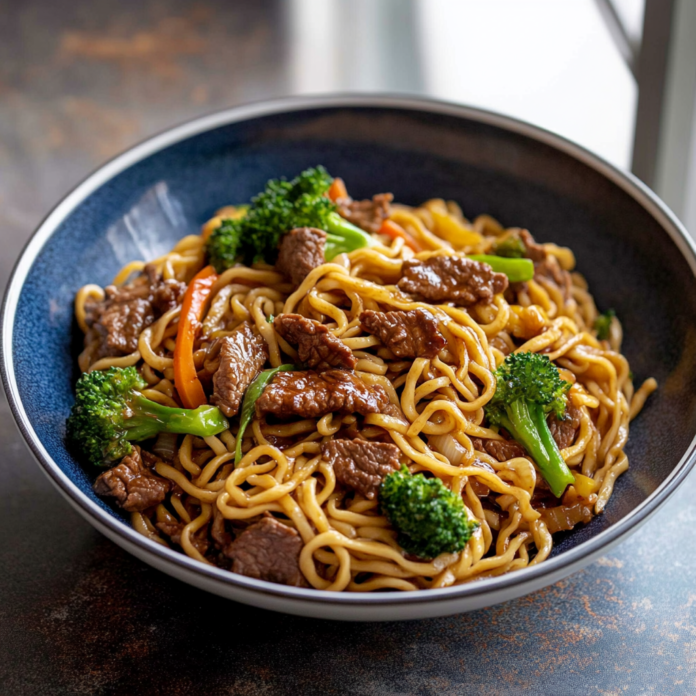Introduction and Quick Summary
When it comes to comfort food, few dishes can compete with the delightful flavors of Beef Lo Mein Noodles. This dish combines tender strips of beef with fresh vegetables and perfectly cooked egg noodles, all coated in a savory sauce that tantalizes your taste buds. Whether you are looking for a quick weeknight dinner or a dish to impress guests, Beef Lo Mein Noodles offer both simplicity and sophistication. With its origins in Chinese cuisine, this stir-fry classic has gained popularity worldwide due to its versatility and mouth-watering taste.
In this comprehensive guide, you will learn how to make your own Beef Lo Mein Noodles from scratch. We will cover the essential ingredients needed for this flavorful dish and provide step-by-step instructions to ensure success in your kitchen. You’ll discover tips for serving and storing your leftover noodles so you can enjoy this dish even after the initial meal is over. So grab your apron and get ready to whip up a delicious plate of Beef Lo Mein Noodles that will have everyone asking for seconds!
Main Ingredients
Fresh Egg Noodles
Fresh egg noodles are the backbone of any great Beef Lo Mein dish. They come pre-cooked or dried but using fresh gives the best texture and flavor. When cooked properly, they become chewy yet tender, absorbing the delicious sauce beautifully. For this recipe, you’ll need about 8 ounces of fresh egg noodles.
Flank Steak
Flank steak is an excellent choice for this dish due to its rich flavor and tenderness when sliced thinly against the grain. About 1 pound is ideal for serving four people. Marinate it briefly to enhance its flavor before cooking; just a simple mix of soy sauce, garlic, and ginger will elevate the meat significantly.
Mixed Vegetables
A colorful mix of vegetables adds crunch and nutrition to your Beef Lo Mein Noodles. You may use bell peppers, carrots, snow peas, and onions — about 2 cups total will suffice. Chop them into bite-sized pieces so they can cook evenly alongside the noodles.
Soy Sauce
Soy sauce provides the umami depth that makes this dish irresistible. You’ll need around 3 tablespoons for seasoning during cooking. Opt for low-sodium soy sauce if you want more control over saltiness while maintaining bold flavors.
Garlic
Garlic adds aromatic richness that complements all ingredients in this dish beautifully. Use 4 cloves minced; it intensifies as it cooks but contributes crucial flavor without overpowering other elements.
Ginger
Fresh ginger enhances the overall taste profile of Beef Lo Mein with its warm spice notes. About 1 tablespoon minced ginger works perfectly in this recipe; it pairs well with garlic and elevates every bite.
Sesame Oil
Sesame oil brings a nutty essence that rounds out flavors in Asian dishes like this one. You’ll only need about 2 teaspoons but be sure not to skip it! Drizzle some on at the end for an aromatic finish.
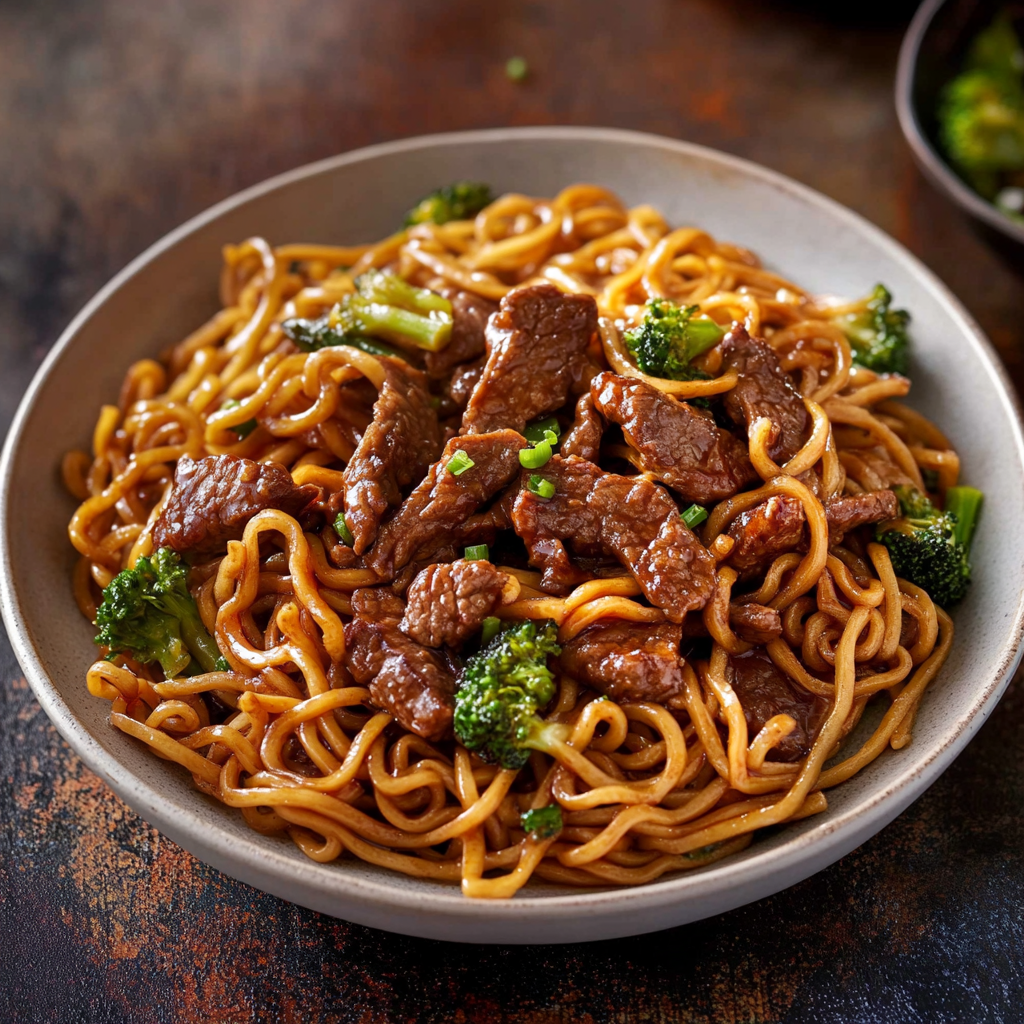
How to Prepare Beef Lo Mein Noodles
Step 1: Marinate the Flank Steak
Begin by marinating the flank steak to infuse it with flavor while tenderizing it at the same time. In a mixing bowl, combine 3 tablespoons of soy sauce with minced garlic (2 cloves) and minced ginger (1 teaspoon). Stir well until combined smoothly then add your flank steak cut into thin strips—aiming for about ¼ inch thickness ensures even cooking later on! Coat each piece thoroughly with marinade before covering tightly with plastic wrap or transferring into a zip-lock bag. Allow it to rest in the refrigerator for at least 30 minutes (or up to overnight if preferred) so that all those delicious flavors meld beautifully into every bite.
Step 2: Cook the Noodles
While your steak marinates away deliciously in those bold flavors—let’s move on to cooking our fresh egg noodles! Begin by bringing a large pot filled with water seasoned generously with salt over high heat until boiling vigorously—this helps season our pasta right from the start! Once boiling fiercely enough where bubbles break through surface tension freely add in approximately 8 ounces (half a package) of fresh egg noodles stirring gently so they don’t stick together as they soften up nicely—usually taking around just 3-5 minutes depending upon brand specifics mentioned on packaging label instructions too! Afterward once completely al dente drain them well through colander then rinse under cold water briefly stopping further cooking process before setting aside until ready for incorporation alongside other ingredients later.
Step 3: Stir-Fry Vegetables
With our marinated flank steak now ready alongside those freshly prepared al dente noodles—it’s time we focus on stir-frying those vibrant mixed veggies next! Grab yourself a large frying pan or wok preheated over medium-high heat drizzling roughly half tablespoon sesame oil inside ensuring coating bottom evenly spreads out before adding chopped bell peppers (one red & one yellow), sliced carrots (two medium-sized ones), snow peas (one cup), plus diced onion (one large). Allowing them all sufficient space within pan while tossing occasionally towards edges allows them achieve perfect caramelization without overcrowding resulting sogginess ruining texture quality later down road! Sauté these beautiful colors together continuously stirring just about three–four minutes maximum until softened yet still crisp retaining freshness vibrancy throughout final plating presentation!
Step 4: Cook The Flank Steak
Now let’s bring back our marinated flank steak from earlier resting patiently waiting its turn—using same hot frying pan/wok used previously add remaining sesame oil drizzled lightly over surface followed by carefully placing each strip onto heated base without overcrowding again ensuring even cooking happens without steaming instead! Searing should take roughly two-three minutes per side allowing natural juices release flavors caramelizing wonderfully creating crusty exterior while inside remains tender juicy perfection you desire! Keep flipping constantly watching closely once browned remove immediately onto plate set aside momentarily reserving any leftover juices within pan itself enhancing future sauce creation soon enough.
Step 5: Combine Everything
Finally we reach grand finale stage where everything comes together harmoniously completing our masterpiece—starting off by returning sautéed vegetables back into same frying pan along alongside cooked flank steak pieces too creating beautiful medley showcasing vibrant colors textures aromas here finally uniting at last as one cohesive entity worth indulging proudly upon serving plate moments ahead! Now sprinkle remaining two tablespoons soy sauce generously throughout mixture tossing gently under heat allowing all elements blend together seamlessly infusing entire batch uniformly full-bodied delectable goodness whilst also ensuring proper heat distribution throughout entirety made possible via thorough stirring motion taking care not break apart any fragile bits unnecessarily during process either please take care here though as timing can dictate results immensely leading potentially dry ends otherwise…
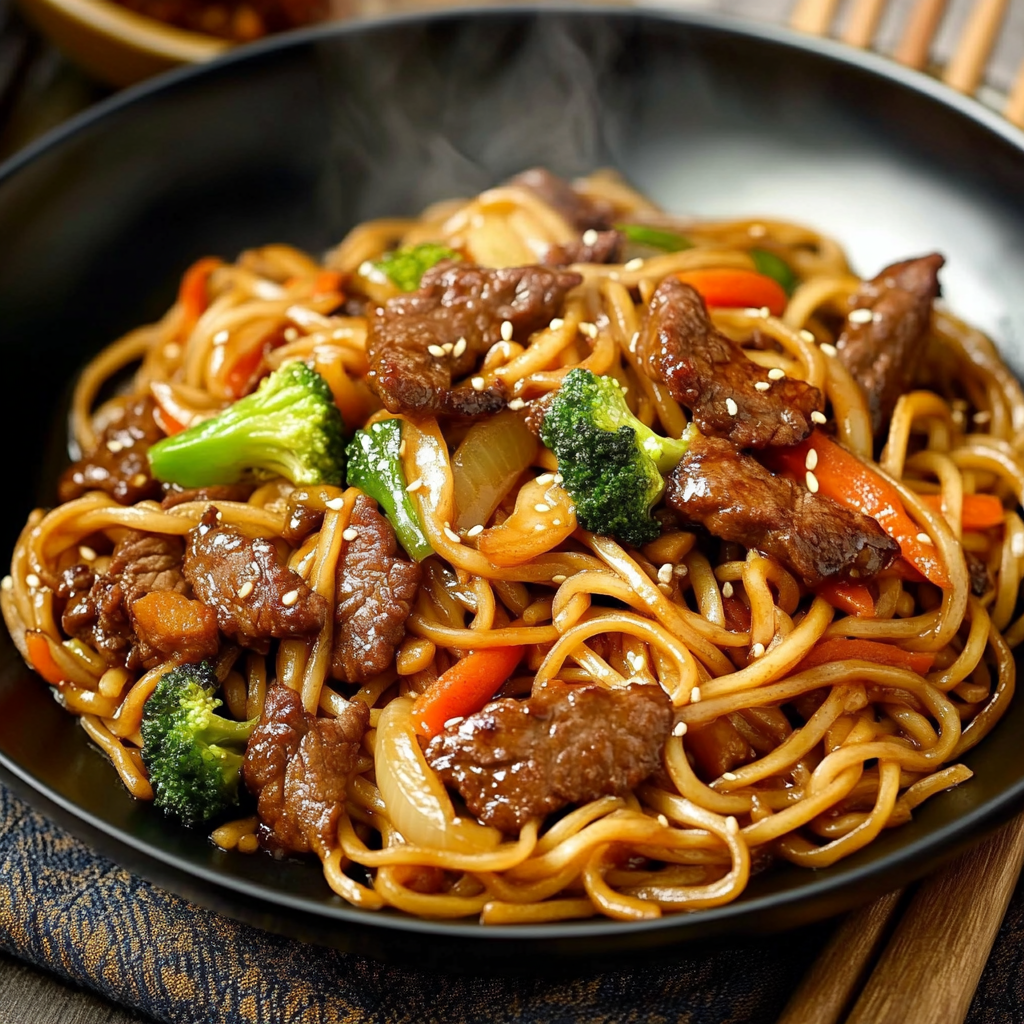
Serving and Storing Tips
Serving Suggestions
When it comes time serve your delightful Beef Lo Mein Noodles there are plenty ways present showcase exquisite artistry behind efforts made preparing too! Plate individual servings family-style garnished freshly chopped scallions atop each bowl providing bright pop color contrast alongside adding subtle onion flavor enhancement truly elevating experience further beyond mere visuals alone enhancing dining pleasure immensely overall too! Additionally consider pairing alongside side dishes like spring rolls or dumplings giving guests variety choices indulge multiple cuisines simultaneously perhaps offering dipping sauces too such sweet chili sauce enhancing appetites even greater levels than expected leaving everyone satisfied beyond measure!
Storage Guidelines
If you find yourself left with leftovers after enjoying scrumptious meal don’t fret—storing properly means extending lifespan preserving integrity flavors textures means enjoying again another day ahead too! For optimal results transfer cooled portions airtight container refrigerate promptly within two hours consuming safely keeping temperature stable below sixty degrees Fahrenheit ideally lasting between three-five days maximum depending upon freshness quality observed beforehand definitely check any signs spoilage prior consumption always being cautious regarding food safety practices suggested standard guidelines established across board universally trusted authority resources available easily accessible online today especially important knowing condition food items kept maintained accordingly ensuring health wellness always prioritized first foremost above anything else shared enjoyed amongst loved ones friends family alike during gatherings hosted frequently across various occasions celebrated regularly year-round preferably!
Mistakes to avoid
One common mistake when preparing Beef Lo Mein Noodles is not cooking the noodles properly. Overcooked noodles can become mushy and lose their texture, which is essential for a great dish. Always follow the package instructions for cooking time, and consider undercooking them slightly since they will continue to cook in the stir-fry process. Aim for al dente noodles to maintain that perfect bite.
Another frequent error is using insufficient oil during the cooking process. A lack of oil can cause the ingredients to stick to the pan, leading to uneven cooking and burnt flavors. Use a high smoke point oil such as canola or peanut oil, which helps achieve that delicious stir-fry taste without compromising the integrity of your dish.
Many home cooks also underestimate the importance of marinating beef. Skipping this step means missing out on deep flavors that enhance your Beef Lo Mein Noodles. A simple marinade with soy sauce, garlic, and ginger can transform your beef into a tender and flavorful protein that complements the noodles perfectly.
Furthermore, neglecting vegetable preparation can ruin your dish’s visual appeal and flavor profile. Make sure to cut vegetables uniformly to ensure even cooking. Choosing a mix of colorful vegetables not only adds nutrition but also makes your plate more visually appealing.
Lastly, don’t forget about seasoning! Using only soy sauce can lead to a one-dimensional flavor profile in your Beef Lo Mein Noodles. Experiment with other seasonings like oyster sauce, sesame oil, or even a splash of rice vinegar for an added depth of flavor. Balance is key; taste as you cook!
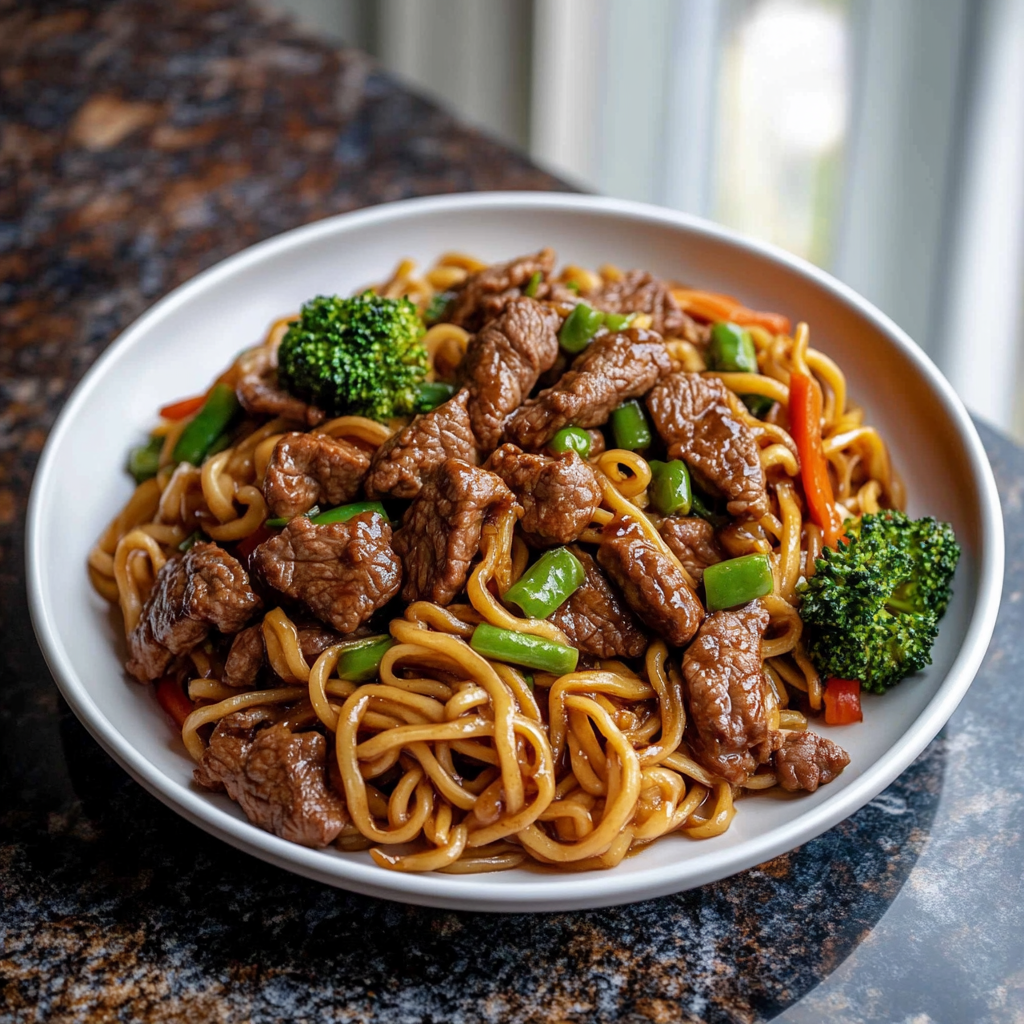
Tips and tricks
To elevate your Beef Lo Mein Noodles, focus on ingredient quality. Fresh vegetables will provide better texture and flavor compared to frozen or canned options. Visit your local market for vibrant bell peppers, crisp bok choy, and crunchy carrots. Fresh ingredients contribute not only taste but also aesthetics to your dish.
Another crucial tip is to prep all ingredients before you start cooking. Stir-frying happens quickly; having everything ready ensures you won’t overcook anything while searching for ingredients mid-cooking. Chop veggies, slice beef, and measure sauces first so that you can add them seamlessly during the stir-fry process.
Consider using a wok instead of a regular frying pan for an authentic experience with Beef Lo Mein Noodles. Woks have a unique shape that allows for even heat distribution while providing ample space for tossing ingredients without spilling any overboard.
When it comes to cooking techniques, always use high heat when stir-frying. This method seals in flavors and ensures a nice char on both vegetables and beef, creating those desirable crispy edges that make this dish so delightful.
Lastly, don’t be afraid to customize! While traditional recipes are fantastic, feel free to add or substitute proteins or vegetables based on preference or what’s available in your pantry. This flexibility allows you to infuse personal touches into your Beef Lo Mein Noodles while keeping them deliciously satisfying.
Suggestions for Beef Lo Mein Noodles
For an authentic touch in your Beef Lo Mein Noodles recipe, consider using fresh egg noodles rather than dried ones if available. Fresh noodles cook faster and have a richer flavor compared to their dried counterparts. They absorb sauces beautifully while maintaining their structure throughout cooking.
Incorporating various proteins can also enhance your dish significantly. While beef is the star ingredient here, adding shrimp or chicken alongside may introduce new textures and flavors while making the dish more filling. Mix-and-match proteins create versatility in serving styles based on dietary preferences.
Don’t shy away from experimenting with sauces! Besides soy sauce as a base, try incorporating hoisin sauce for sweetness or sriracha for heat if you enjoy spice in your meals. Mixing different sauces allows you to tailor flavors according to personal taste preferences.
Pairing your Beef Lo Mein Noodles with complementary side dishes can complete the meal experience beautifully. Consider serving spring rolls or dumplings as an appetizer followed by this noodle dish; it makes for an enjoyable dining experience filled with variety.
Finally, keep portion sizes in mind when serving Beef Lo Mein Noodles at gatherings or family dinners. It’s easy to prepare too much when cooking in bulk; however, leftovers may lose their texture upon reheating due to moisture loss over time. Aim for well-balanced portions so everyone gets enough without waste!
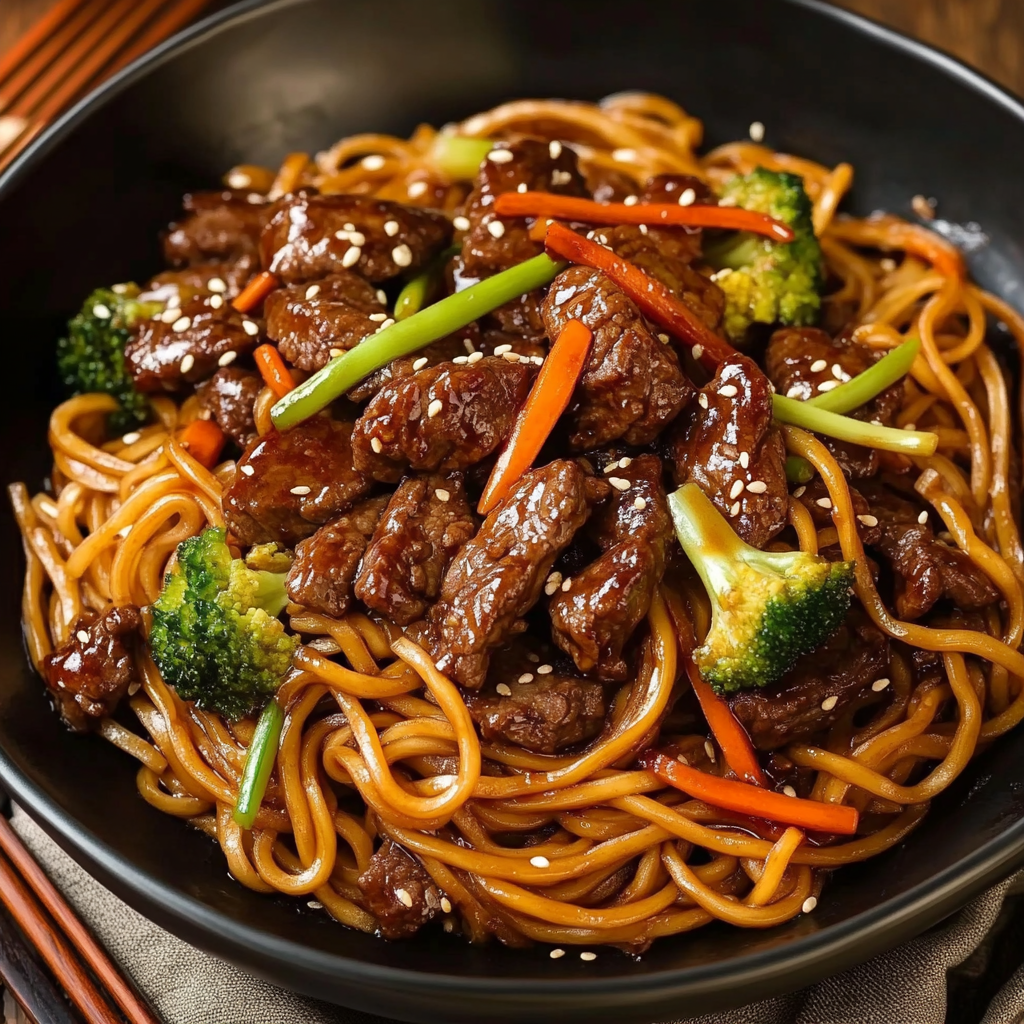
FAQs
What are the best types of noodles for Beef Lo Mein Noodles?
The best types of noodles for Beef Lo Mein are fresh egg noodles or lo mein noodles specifically designed for stir-frying dishes. Fresh egg noodles have a delightful chewiness that holds up well against saucy stir-fries while absorbing flavors easily from the accompanying ingredients like beef and vegetables.
Dried lo mein noodles are another suitable option if fresh ones aren’t available; just ensure they’re cooked al dente before adding them into the stir-fry mix since they’ll continue cooking once combined with hot ingredients in the wok.
How do I properly store leftover Beef Lo Mein Noodles?
To store leftover Beef Lo Mein Noodles correctly, let them cool completely before transferring them into an airtight container. Refrigerate within two hours after cooking—this helps maintain freshness while preventing bacterial growth.
Leftovers typically remain safe for consumption up to three days when stored correctly in refrigeration conditions; however, consider reheating thoroughly before enjoying again! For best results during reheating processes use stovetop methods instead of microwaves whenever possible as this retains moisture better than other methods might allow.
Can I make Beef Lo Mein Noodles vegetarian-friendly?
Absolutely! You can easily adapt traditional Beef Lo Mein recipes by replacing beef with plant-based proteins such as tofu or tempeh while ensuring similar seasoning levels are present throughout these substitutions.
Additionally swapping out certain sauces containing animal products (like oyster sauce) with vegetarian alternatives ensures full compliance when creating meatless variations without sacrificing flavor profiles usually found within classic recipes!
What vegetables work best in Beef Lo Mein Noodles?
Beef Lo Mein can benefit from various vegetable additions based on personal preference! Popular options include bell peppers (red/yellow/green), broccoli florets/bok choy/carrots/snap peas/mushrooms/zucchini—all contribute texture/color/flavor enhancing overall enjoyment levels associated with this delightful noodle dish!
Feel free experimenting further according seasonal availability ensuring fresh produce brings vibrancy & nutrition along every bite enjoyed!
How spicy should my Beef Lo Mein Noodles be?
Spice levels vary widely across individual tastes! Start by incorporating small amounts of sriracha/chili paste/pepper flakes gradually until achieving desired heat level suits palate preferences—this approach prevents overwhelming diners who may prefer milder dishes overall consistency remains intact throughout preparation stages involved therein!
Remember—the goal is balancing heat alongside other flavors present throughout meal experiences shared collectively amongst friends/family alike!
Can I freeze my cooked Beef Lo Mein Noodles?
While it’s possible freezing cooked versions—this isn’t always recommended due textural changes occurring post-thawing resulting mushiness alongside lacking quality experienced during initial preparation stages themselves instead reheating leftovers freshly prepared yields optimal enjoyment levels achieved consistently every time served thereafter enjoyed togetherness moments shared around dinner tables everywhere!
Conclusion
In summary, creating delicious Beef Lo Mein Noodles involves avoiding common mistakes such as overcooking noodles or neglecting proper seasoning techniques throughout preparation processes involved therein! By following tips regarding ingredient quality/prep work + utilizing effective cooking methods (high heat/introduction fresh components), elevating dishes becomes manageable effortlessly achieved overtime spent honing culinary skills practiced regularly together amongst loved ones gathered around dining tables sharing joyful moments togetherness experienced through meals prepared lovingly each day enhancing connections made enduring memories shared joyously forevermore!
